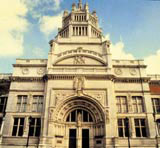Show business
Victoria & Albert Museum design head Moira Gemmill is one month into the job and keen to establish a first-class design team.

By her own admission, Moira Gemmill has joined the Victoria & Albert Museum as head of design at a stimulating time. The long-awaited British Galleries opened just before Christmas, entry to the museum is free again, visitor numbers are on the up (December 2001 registered a four-fold increase on 2000), and work on the hotly-anticipated Daniel Libeskind Spiral extension is finally due to start next year.
Gemmill, a stylish Scot, joined on 7 January, eight months after director Mark Jones. By chance, she started her previous post, as head of design and exhibitions at the Museum of London, at almost the same time as director Simon Thurley, the ‘boy wonder’ of the museum world, who has just joined English Heritage as head.
‘[Thurley] made several changes in a very short space of time, in particular increasing the number of temporary exhibitions we were able to stage,’ she says.
But it was the type of exhibitions the Museum of London started to put on that really caught people’s eyes. London Bodies, for example, which featured skeletons to illustrate the changing physical appearances of Londoners, had ‘enormous impact’.
Thurley has a much-admired flair for publicity. When the Museum of London’s archeologists dug up a stone sarcophagus in London’s Spitalfields with a Roman coffin inside, he took it straight to the museum’s galleries and opened it live on television, ensuring blanket next-day press coverage.
The museum even established satellite ‘outsites’ to exhibit archeological finds in the corporate headquarters under which they were discovered, with highly visible museum branding. I suggest a chain of regional V&A museums. ‘How fantastic. That would be enormously exciting and fantastic for profile-raising,’ she says.
Gemmill’s measured speech is peppered with exclamations and strong adjectives, such as ‘spectacular’, ‘incredible’, ‘fantastic’ and ‘enormously’, revealing a real passion for her work.
Also, publicity is something Gemmill mentions time and again. ‘Temporary exhibitions cost a lot of money and take up lots of a museum’s resources. If you get it wrong and don’t generate media and public interest and raise the profile of the museum, they are a waste of money,’ she says.
It remains to be seen if the V&A’s profile could benefit from this approach. But exhibitions, alas, do not fall under Gemmill’s remit as head of design, although she says the museum can be braver than it has so far with the types of exhibitions it stages.
Her role reflects the very nature of the V&A itself, something ringingly endorsed by Jones. Design is ‘central to our purpose’ and ‘at the head of everything we do’, he says.
One of the first things Gemmill is keen to address is signage, a ‘perennial’ problem for museums, she says. ‘Signage is often introduced piecemeal, for instance, when a new exhibition opens, but it might be several years before the rest of the museum catches up. And, of course, there is never enough money to scrap it all and start again.’
But she intends to fight her corner. ‘It’s not rocket science, we just have to make it simpler for people to navigate the building or we are spoiling their visit,’ she says.
Longer term, her aim is to establish a first-class internal design team with an excellent reputation. This won’t lead to less work with external consultancies as ‘there will never be a big enough internal team to carry out all the work’, she says.
In fact, she is keen to work with more non-museum design specialists. It could be a huge learning curve for them and the results may be spectacular, she says. ‘It is a rather insulting perception that if a designer is recognised as, say, a restaurant designer, they can’t do anything else,’ she says.
Gemmill also intends to tighten up design commissioning within the museum. ‘I want to find out how that side of things functions and how successful it is,’ she says.
A role focused purely on design suits Gemmill as it is, after all, where she began. She studied graphic design at Glasgow School of Art, followed by a spell in publishing before taking a job at Aberdeen Art Gallery. She remains passionate about graphics and says that ‘a consistent graphic strategy is vital within a museum environment’. When she arrived at the Museum of London, its posters looked ‘as if they belonged to a different museum’, and had no coherent style. She is keen to strengthen the V&A’s graphics in the same way, but acknowledges there is less that needs to be done.
The ‘elegant’ V&A logo by Alan Fletcher will stay, ‘absolutely’, she adds, but it needs to work harder than it does. Fundamentally, she says, design should support the content of a museum or exhibition, which is king. ‘I don’t like [exhibitions] to be design-led – that misses the point.’ For a designer, that’s a bold, but fair, statement.
Moira Gemmill’s CV
Education: Glasgow School of Art, BA in Art and Design
Career: Set up Citygirl Magazine aimed at working women, published in Aberdeen and Glasgow; head of programme support, Aberdeen Art Gallery and Museums; head of design and exhibitions, Museum of London; head of design, Victoria & Albert Museum
-
Post a comment



